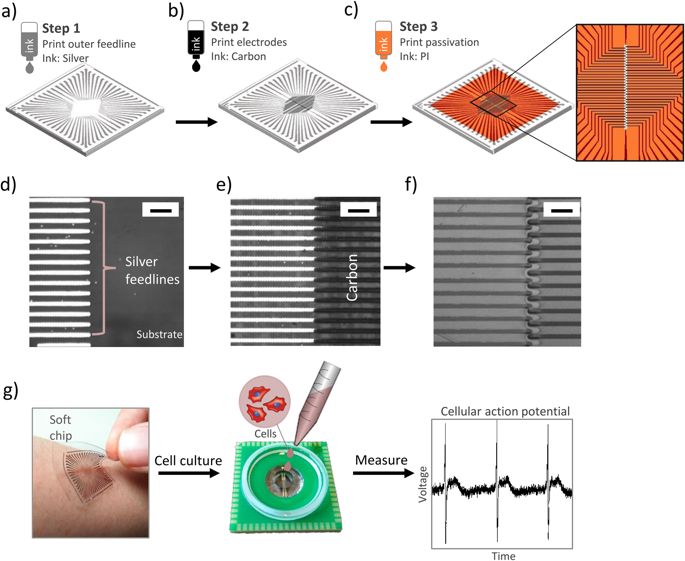npj Flexible Electronics ( IF 12.3 ) Pub Date : 2018-05-24 , DOI: 10.1038/s41528-018-0027-z Nouran Adly , Sabrina Weidlich , Silke Seyock , Fabian Brings , Alexey Yakushenko , Andreas Offenhäusser , Bernhard Wolfrum

|
Microelectrode arrays (MEAs) provide promising opportunities to study electrical signals in neuronal and cardiac cell networks, restore sensory function, or treat disorders of the nervous system. Nevertheless, most of the currently investigated devices rely on silicon or polymer materials, which neither physically mimic nor mechanically match the structure of living tissue, causing inflammatory response or loss of functionality. Here, we present a new method for developing soft MEAs as bioelectronic interfaces. The functional structures are directly deposited on PDMS-, agarose-, and gelatin-based substrates using ink-jet printing as a patterning tool. We demonstrate the versatility of this approach by printing high-resolution carbon MEAs on PDMS and hydrogels. The soft MEAs are used for in vitro extracellular recording of action potentials from cardiomyocyte-like HL-1 cells. Our results represent an important step toward the design of next-generation bioelectronic interfaces in a rapid prototyping approach.
中文翻译:

在柔软材料上印刷微电极阵列:从PDMS到水凝胶
微电极阵列(MEA)为研究神经元和心脏细胞网络中的电信号,恢复感觉功能或治疗神经系统疾病提供了有前途的机会。然而,当前研究的大多数设备都依靠硅或聚合物材料,它们既不物理模拟也不机械匹配活组织的结构,从而引起炎症反应或功能丧失。在这里,我们提出了一种新的方法来开发软MEA作为生物电子界面。使用喷墨印刷作为构图工具,将功能结构直接沉积在基于PDMS,琼脂糖和明胶的基材上。我们通过在PDMS和水凝胶上印刷高分辨率碳MEA证明了这种方法的多功能性。软MEA用于体外记录心肌样HL-1细胞的动作电位。我们的结果代表了快速原型方法朝着下一代生物电子接口设计迈出的重要一步。











































 京公网安备 11010802027423号
京公网安备 11010802027423号